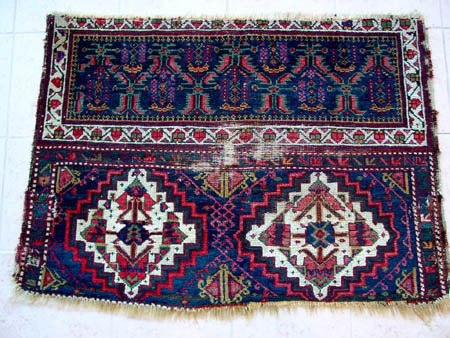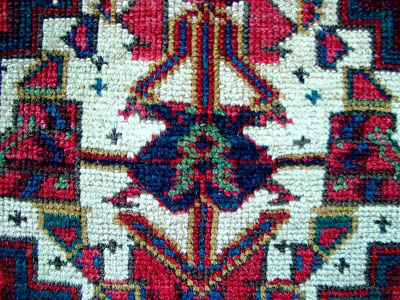Part 2:
by Patrick Weiler
Salt Bags
OK, enough of the really expensive stuff, let’s look at a more
pedestrian piece:

I would call this fragmented salt bag an Afshar. As you can see, it is rather tattered. It has holes, gouges, raggedy edges and is missing most of the warp “ropes” at the top.

This almost looks like what one would consider the back of the bag, but it is the front. Here is the back:

Salt would not stay in this bag for very long. Was it used for
something else? The salt they used was not what we think of as table
salt.
It was large pieces of rock salt for their sheep, so a few
little holes would not matter too much, although salt was an expensive
commodity.
It is difficult to imagine this much wear to a utilitarian
object that could still be used for carrying something. Perhaps
that is
why it ended up at Sotheby’s, selling for a world record price. Of
course I may have my salt bags mixed up. Perhaps this is NOT
the world record salt bag. As a matter of fact, there probably
is no record
of what the most expensive salt bag sold for. If you are aware
of the record salt bag price, let us know.
Here is a picture of what an UN-fragmented salt bag would look like:

It is quite likely also Afshar. The row of rosettes at the bottom and the top of the bag may be indicators of a Varamin origin. You can see that many of the warp “ropes” at the top of the bag are intact. These have been used for carrying the bag on the staff of a shepherd. In this carrying mode, the top of the bag would flop over to keep the contents from spilling out.
Malatya
Here is a piece that is only 1/3 or 1/6 of the original:

This is the top third of a Malatya kilim. An example woven in two pieces is shown in Tribal Rugs, by Jenny Housego, plate 49 (19). Housego noted that such pieces have been attributed to Jalali Kurds of NW Iran or eastern Turkey. Another example is shown in The Tribal Eye: Antique Kilims of Anatolia, by Peter Davies (20). You can readily see that the top of the weaving has a knotted fringe. This close up shows that it was cut across the bottom:

You can also see the deeply saturated colors and typical Kurdish motifs. I found this piece when looking through the window of a small antique store that was closed. A small section of it was sticking out from under a pile of nondescript textiles on the floor a few yards from the window. The store was only open one day a week. I could see that it was a wonderful thing, but had no idea what it was. I patiently waited until the day the store was open again and pulled it out from under the pile. The elderly owner had no clue that this unseemly fragment could have much value. I eagerly purchased the piece and began a search for its origin. The store closed for good a couple of weeks later. Saved from the garbage dump!
Box Cover
Another fragment that at first glance does not look fragmentary is
this Kurdish piece:

These enigmatic weavings have been speculated to be box
covers. This would be either the top or bottom section, with
a plain field pile middle section in between. None of the known
examples have
fold wear where the edges of the various field sections border each
other. There is one interesting wear point on this piece, at
either side of the bottom half there is a chunk of the border that
has been
patched with what may have been pieces of the other end of this weaving.
I speculate that if this was a box cover, there may have been
straps attached there that tore away and were repaired when the piece
was
separated.
Here is a closer view:

The variety of colors, the quirky drawing and the odd juxtaposition of completely different designs make this a very unusual fragment.
SW Persian
Here is a real old-timer:

You can see a hole just above the medallion. The
pile is worn nearly all over, except in the lower portion of the field.
Dating a piece like this is problematic due to there not being any
identical pieces in the literature. It may predate the Khamseh
confederation of the mid 19th century. A close examination
of the field shows a nuclear reactor in the center, surrounded by genetically
defective animals. Camels with glowing humps.
Foxes with red eyes. Lions without heads. Mutated scorpions
and fantastical flowers. Here is a close up of one corner:

You can see the person at the bottom of the field, to the right, wearing a radiation suit with a large white helmet and four blue antennae. His arms are sticking out and his gloved hands hold glowing red radioactive material. Above him are two horses in a decontamination chamber.
Why buy fragments?
Fragments can be rewarding to collect for a variety of reasons. The
history and lives of the weavers are interwoven into these tapestries
of their past. You may find a fragment that is unusual. You
may find a fragment that you can afford even if you could not afford
a complete
piece in good condition. You may find fragments that are useful
in understanding types, weaves, dyes and designs. You may be
attracted to the mystery. You may collect fragments
because there are no complete pieces of the type available. The
colors are fabulous. And many fragments just plain look great.
Just because a piece is fragmentary does not mean it is not
good. There
are a whole lot of complete rugs that make these fragments look like
masterpieces.
There are not many people who collect fragments of old paintings, or fragments of old books or old furniture. Rug collectors, though, can collect fragments of old rugs with their heads held high and their integrity intact. Sigmund Freud collected fragments of statuary from antiquity, headless bodies, body-less heads, armless torsos, even a few full statues of diminutive stature. So, to end our fragmentary travels, here is one final fragment for your enjoyment. Now, lie back on the couch and tell me all about your fragments………….

Notes and References:
(1) http://www.rugreview.com/orr/131timm.htm
(2) Definitions from http://www.yourdictionary.com
(3) http://search.sothebys.com/jsps/live/lot/LotDetail.jsp?sale_number=N07946&live_lot_id=69
(4) http://www.bonhams.com/cgi-bin/wspd_cgi.sh/pubweb/publicSite.r?screen=NewlotdetailsNH&iSaleItemNo=1459767&iSaleNo=11051&sPath=2004-03/03/4138442-4-2.jpg
(5) http://www.iath.virginia.edu/~jmu2m/gp/
(6) http://www.ne-rugsociety.org/gallery/collectors-eye/catalogue-32.htm
(7) http://www.sfbars.org/more.html
(8) Pat Weiler, Turkotek Salon 10/04
(9) http://www.marlamallett.com/offset-b.htm showing a fostat fragment
from
Carl Johan Lamm, Carpet Fragments, Uddevalla, Sweden, 1985
(10) http://www.tcoletribalrugs.com/article15baluchstyle.html
(11) http://www.sunchronicle.com/articles/2004/06/26/opinion/opinion5.txt
(12) http://www.strum.co.uk/scratch/doilies.htm
(13) http://www.freep.com/features/living/ten7_20000607.htm
(14) http://www.turkotek.com/salon_00092/salon.html
(15) http://www.rugreview.com/orr/or106cov.jpg
(16) HALI # 134, Pinner collection.
(17) http://www.turkotek.com/mini_salon_00003/ms3t14.htm
(18) http://www.rugreview.com/orr/6rugnote.htm
(19) Tribal Rugs, by Jenny Housego
(20) The Tribal Eye: Antique Kilims of Anatolia, by Peter
Davies
(21) http://www.writing.upenn.edu/~afilreis/freud-couch.html